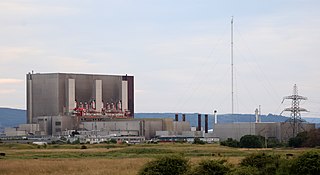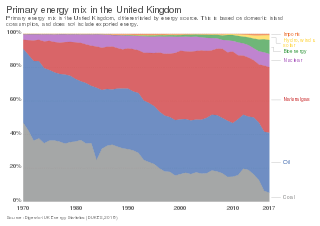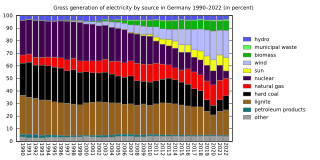List of active power stations
| Name | Location | Owner | Date commissioned | Planned closure date | Total capacity (GW) | Notes | Image |
|---|---|---|---|---|---|---|---|
| Ratcliffe on Soar | Nottinghamshire | Uniper | 1968 [16] | September 2024 [17] | 2.00 |  |
There is currently one active coal-fired power station operating in the United Kingdom, Ratcliffe-on-Soar in Nottinghamshire. [1] It has a total generating capacity of 2 GW; however one unit has been put into a preservation state prior to the plant's decommissioning, thereby reducing the generating capacity to 1.5 GW.
In November 2015, the UK Government announced that all the remaining fourteen coal-fired power stations would be closed by 2025. [2] In November 2017 the UK Government co-founded the Powering Past Coal Alliance. In June 2021, the government said it would end coal power by October 2024. [3] [4]
| Site | Date of cessation | Notes |
|---|---|---|
| Ironbridge | Late 2015 | |
| Rugeley Ferrybridge Longannet | 2016 | |
| Eggborough | 2018 | Was granted consent to convert into a gas fired power station. |
| Lynemouth | 2018 | Converted to biomass |
| Uskmouth | Being[ when? ]converted to an energy from waste plant. | |
| Cottam Aberthaw | 2019 | [5] |
| Fiddlers Ferry | 2020 | [6] |
| Drax | March 2021 | Stopped burning coal. [7] |
| West Burton A Kilroot | 2023 | [8] [9] |
The United Kingdom had continuously burned coal for the generation of electricity since the opening of Holborn Viaduct power station in 1882. On 21 April 2017, for the first time since 1882, the GB grid had a 24-hour period without any generation from coal power. [10] In May 2019 the GB grid went its first full week without any coal power. [11] In May 2020 the GB grid beat the previous record and did not use coal generation for over a month. [12]
At present, the use of coal power is decreasing to historic lows not seen since before the Industrial Revolution. Coal supplied just over 1% of UK electricity in 2023, [13] down from 30% in 2014. [14] In 2020, coal produced 4.4 TWh of electricity and Britain went 5,202 hours free from coal electricity generation, up from 3,665 hours in 2019 and 1,856 in 2018. [15]
| Name | Location | Owner | Date commissioned | Planned closure date | Total capacity (GW) | Notes | Image |
|---|---|---|---|---|---|---|---|
| Ratcliffe on Soar | Nottinghamshire | Uniper | 1968 [16] | September 2024 [17] | 2.00 |  |

Electricity generation is the process of generating electric power from sources of primary energy. For utilities in the electric power industry, it is the stage prior to its delivery to end users or its storage, using for example, the pumped-storage method.

A power station, also referred to as a power plant and sometimes generating station or generating plant, is an industrial facility for the generation of electric power. Power stations are generally connected to an electrical grid.

Fiddler's Ferry power station is a decommissioned coal fired power station located in Warrington, Cheshire, England. Opened in 1971, the station had a generating capacity of 1,989 megawatts and took water from the River Mersey. After privatisation in 1990, the station was operated by various companies, and from 2004 to 2022 by SSE Thermal. The power station closed on 31 March 2020. The site was acquired by Peel NRE in July 2022.

The National Grid is the high-voltage electric power transmission network serving Great Britain, connecting power stations and major substations, and ensuring that electricity generated anywhere on the grid can be used to satisfy demand elsewhere. The network serves the majority of Great Britain and some of the surrounding islands. It does not cover Northern Ireland, which is part of the Irish single electricity market.
India is the third largest producer of electricity in the world. During the fiscal year (FY) 2022–23, the total electricity generation in the country was 1,844 TWh, of which 1,618 TWh was generated by utilities.

Japan is a major consumer of energy, ranking fifth in the world by primary energy use. Fossil fuels accounted for 88% of Japan's primary energy in 2019. Japan imports most of its energy due to scarce domestic resources. As of 2022, the country imports 97% of its oil and is the larger LNG importer globally.

Hartlepool nuclear power station is a nuclear power station situated on the northern bank of the mouth of the River Tees, 2.5 mi south of Hartlepool in County Durham, North East England. The station has a net electrical output of 1,185 megawatts, which is 2% of Great Britain's peak electricity demand of 60 GW. Electricity is produced through the use of two advanced gas-cooled reactors (AGR). Hartlepool was only the third nuclear power station in the United Kingdom to use AGR technology. It was also the first nuclear power station to be built close to a major urban area.

EDF Energy is a British integrated energy company, wholly owned by the French state-owned EDF, with operations spanning electricity generation and the sale of natural gas and electricity to homes and businesses throughout the United Kingdom. It employs 11,717 people, and handles 5.22 million business and residential customer accounts.

Energy in the United Kingdom came mostly from fossil fuels in 2021. Total energy consumption in the United Kingdom was 142.0 million tonnes of oil equivalent in 2019. In 2014, the UK had an energy consumption per capita of 2.78 tonnes of oil equivalent compared to a world average of 1.92 tonnes of oil equivalent. Demand for electricity in 2014 was 34.42 GW on average coming from a total electricity generation of 335.0 TWh.

The energy policy of the United Kingdom refers to the United Kingdom's efforts towards reducing energy intensity, reducing energy poverty, and maintaining energy supply reliability. The United Kingdom has had success in this, though energy intensity remains high. There is an ambitious goal to reduce carbon dioxide emissions in future years, but it is unclear whether the programmes in place are sufficient to achieve this objective. Regarding energy self-sufficiency, UK policy does not address this issue, other than to concede historic energy security is currently ceasing to exist.

The United Kingdom is the best location for wind power in Europe and one of the best in the world. The combination of long coastline, shallow water and strong winds make offshore wind unusually effective.

Many countries and territories have installed significant solar power capacity into their electrical grids to supplement or provide an alternative to conventional energy sources. Solar power plants use one of two technologies:

Drax Group plc, trading as Drax, is a power generation business. The principal downstream enterprises are based in the UK and include Drax Power Limited, which runs the biomass fuelled Drax power station, near Selby in North Yorkshire. The Group also runs an international biomass supply chain business. The company is listed on the London Stock Exchange and is a constituent of the FTSE 250 Index.

A coal-fired power station or coal power plant is a thermal power station which burns coal to generate electricity. Worldwide there are over 2,400 coal-fired power stations, totaling over 2,130 gigawatts capacity. They generate about a third of the world's electricity, but cause many illnesses and the most early deaths, mainly from air pollution. World installed capacity doubled from 2000 to 2023 and increased 2% in 2023.

Renewable energy in the United Kingdom contributes to production for electricity, heat, and transport.

China is the world's largest electricity producer, having overtaken the United States in 2011 after rapid growth since the early 1990s. In 2021, China produced 8.5 petawatt-hour (PWh) of electricity, approximately 30% of the world's electricity production.

Coal phase-out is an environmental policy intended to stop burning coal in coal-fired power plants and elsewhere, and is part of fossil fuel phase-out. Coal is the most carbon-intensive fossil fuel, therefore phasing it out is critical to limiting climate change as laid out in the Paris Climate Agreement. The International Energy Agency (IEA) estimates that coal is responsible for over 30% of the global average temperature increase above pre-industrial levels. Some countries in the Powering Past Coal Alliance have already stopped.

The National Grid covers most of mainland Great Britain and several of the surrounding islands, and there are interconnectors to Northern Ireland and to other European countries. Power is supplied to consumers at 230 volts AC with a frequency of 50 Hz. In 2023 about a third of electricity used in Britain was generated from fossil gas and two-thirds was low-carbon power. Wind generates the most low-carbon power, followed by nuclear some of which is imported from France. The government is aiming for greenhouse gas emissions from electricity in Britain to be net zero by 2035.

Germany's electrical grid is part of the Synchronous grid of Continental Europe. In 2020, due to COVID-19 conditions and strong winds, Germany produced 484 TW⋅h of electricity of which over 50% was from renewable energy sources, 24% from coal, and 12% from natural gas, this amounting to 36% from fossil fuel. This is the first year renewables represented more than 50% of the total electricity production and a major change from 2018, when a full 38% was from coal, only 40% was from renewable energy sources, and 8% was from natural gas.

Turkey uses more electricity per person than the global average, but less than the European average, with demand peaking in summer due to air conditioning. Most electricity is generated from coal, gas and hydropower, with hydroelectricity from the east transmitted to big cities in the west. Electricity prices are state-controlled, but wholesale prices are heavily influenced by the cost of imported gas.